2019 in solar: 5 predictions for the new year
2018 was an eventful year for solar energy.
The year saw a number of record-low prices for PPAs in both Europe and America – reportedly even as low as just $25 per megawatt-hour. The year also saw a number of European countries dramatically moving up a gear in their development of renewable energy.
Notably the Netherlands and France announced their intentions toinstall 6-8 GW and 4 GW of new solar annually.
With even that in mind, it seems hard to believe that solar energy can continue its rise in 2019, but nevertheless Obton’s Chief Project Officer, Bent Hansen, highlights a few trends to watch.
Prediction #1: Utility scale storage
- For renewable energy to play a more leading role in the energy system of the future, we should keep trying to find better ways of tackling the storage challenge. Utility scale storage is still in its infancy in Europe, but we are moving closer towards a storage revolution, he says, pointing to a U.S. energy storage market that has seen a slow trickle of utility-scale storage projects in 2018.
- We have yet to see viable investment opportunities for us in energy storage, but I’m confident these will soon come as batteries fall in price and increase in efficiency.
Prediction #2: The rise of the PPA's
As we have previously mentioned, the solar energy sector is gradually reducing its dependence on government subsidies and support schemes. In the future, corporate buyers or utility companies will increasingly enter into Power Purchase Agreements (PPAs) directly with developers, says Bent Hansen.
- We’ve already seen a number of these PPAs signed in Spain, where the irradiance conditions for solar energy are still among the best in Europe. This trend is likely to pick up speed in 2019, he says. He adds that the Spanish government has simultaneously announced two renewable energy auctions for 3.9 GW of solar capacity to be completed by 2020. By way of comparison, Spain added a total of just 4.4 GW of solar capacity between 2007 and 2012.
- After a setback in 2013, Spain now looks committed to cutting its dependence on fossil fuels and nuclear energy, and that commitment is just as important as those made in countries such as France and Germany, says Bent Hansen.
Prediction #3: The end of ever-increasing efficiency?
The solar energy market has become accustomed to ever-increasing solar panel efficiency and falling prices. At the moment, panel prices in Europe are exceptionally favorable due to the trade war between U.S. and China, but eventually prices are expected to stabilize.
- It is harder to predict when the rate of efficiency gains in panel development will slow down. At the moment, bifacial solar panels look to be on the brink of entering the mainstream market, which will improve the efficiency of future solar PV facilities. Studies have shown that bifacial panels offer up to 11% more energy than normal ones, says Bent Hansen.
Prediction #4: The impact of Brexit
Not even close observers of British and European politics dare to make a firm prediction regarding the outcome of the Brexit negotiations. There is little doubt that a so-called “hard” or “no-deal” Brexit could have serious economic consequences for the UK – and maybe also for the EU as well.
Furthermore, as already seems clear from British politics, the Brexit negotiations are so momentous that they overshadow most other policy issues.
- A messy Brexit has the potential to zap the political will to tackle other issues – such as the transformation of the energy system, says Bent Hansen.
Prediction #5: The internal energy market
The outcome of the Brexit negotiations may also have huge impact on the future of the European energy market. EU member states are moving closer towards a common European energy market through ever-expanding climate and energy legislation. The UK imports both gas and electricity from EU member states, as well as serving as a transit country between Ireland and continental Europe.
- A no-deal Brexit may result in higher energy bills to European consumers due to the threat of trade barriers to energy. Both the EU and UK have a shared interest in reaching an agreement that involves the continued integration of the energy market, says Bent Hansen.
At an EU level, member states are still only gradually moving away from the traditional system of nationally-centralized, fossil-based energy to a decentralized system across borders. The EU’s Clean Energy Package from 2018 was an important step in this direction, and 2019 may prove to be the year that the EU’s internal energy market finally takes shape.
- The internal energy market is a necessity to make the transition from fossil-based energy systems to systems based on renewables as cheap as possible for consumers, says Bent Hansen.






